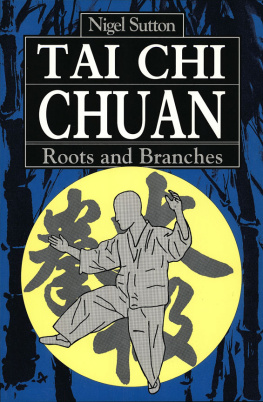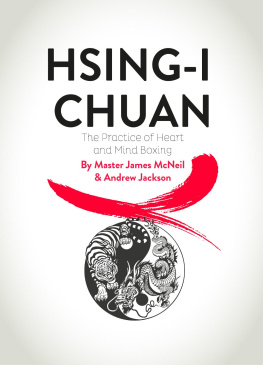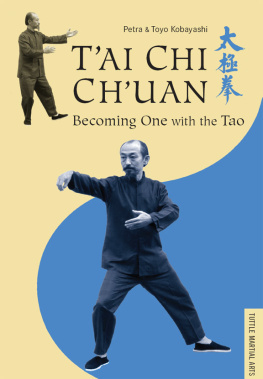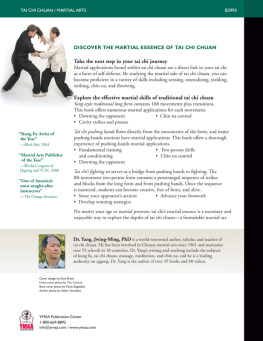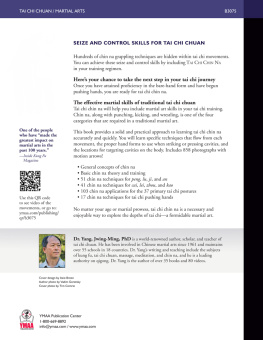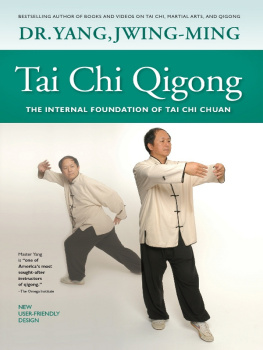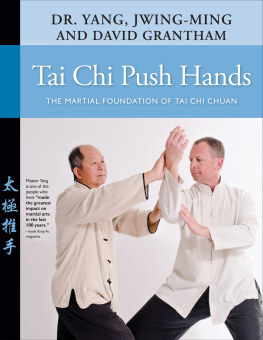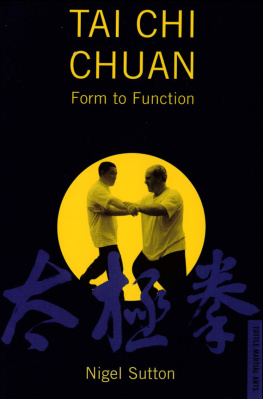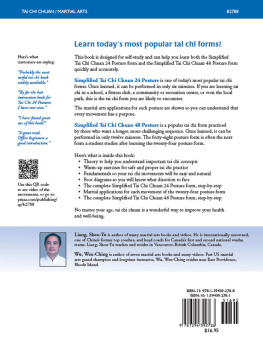" Things have their root and their branches.
Affairs have their end and their beginning.
Confucius.
PART 1 - FORM
Chishi - Beginning
When standing at the beginning it is best to use this opportunity to run through the checklist described earlier to ensure that your body is as relaxed as possible.
The first six leg and arm movements serve to direct your attention to the vital joints and the importance of relaxing and opening them. They are: the hip, knee and ankle in the leg and the shoulder, elbow and wrist in the arm. As you run though these moves all the joints in turn are opened and relaxed. At the same time your body sinks, the waist relaxes and you prepare yourself for the movements to follow.
As you stand quietly you should also relax your mind, endeavouring to focus completely on your movements. The first step in this mental preparation consists of "sinking the qi to the dantian". All that this piece of tai chijargon means is that you should be aware of the dantian area, for according to Chinese thought where the mind goes the qi follows. What this serves to do in practical terms is to focus your attention on the centre of gravity This gives you a kind of mental anchor as you prepare to run though the form, and with time you will find that you develop the ability to remain mentally calm while thinking of several different things in close succession. This mental state is of vital importance if you are to use tai chi chuan as a martial art, for you must be prepared to respond to an opponent's attack while preserving your own state of calm.
Once you have achieved the appropriate mental state you may carry out the following moves:
You start the form standing in a loose attention position, hands by your sides, palms facing in and with your feet together, heels touching. Now is the time to run through your mental checklist, starting from the top of the head and working down.
First we carry out the six leg movements and then the six arm movements.
Transfer your weight to the right foot and then sink down by bending your right knee. As you drop allow the knee to sink down and in, naturally pivoting the left foot inwards on the toes. This ensures that your right hip and buttock remain relaxed. As you sink your palms turn to face the rear, fingers extended in the "fair lady's hand".
In the second move you turn your waist about forty-five degrees to the left allowing the legs to open as the left foot pivots out on the toe. This enables the left hip to remain loose and relaxed.
Next you step out with the left foot, placing it down heel first, a shoulder-width's distance away from the right foot. Then turn the foot to face forward, pivoting on the heel. Throughout this move the weight remains on the right foot.
Now vou can simply shift the weight across to the left. This is the fourth move in the sequence.
The fifth move simply consists of turning the right foot, with the heel as the pivotal point, so that it faces directly forward.
The sixth and final move involving the legs is a simple shift of the weight to the right until it is distributed equally between them.
Next are the arm movements. Remember to keep your hands in the requisite position.
The first move is to raise both arms directly in front of you until the wrists are just above waist level, palms facing down. At this point you should feel as if your shoulder muscles are just about to start working. This we want to avoid at all times when doing tai chi.
To avoid this, sink both elbows. This is the second move.
From there raise the wrists up as if they were attached to wires until your hands are at approximately chest height.
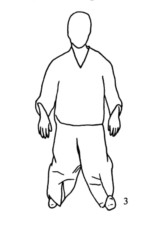
Next push your arms forward so that your fingers are rising up on a diagonal away from you. Again avoid engaging the shoulder muscles so stop when your wrists are at shoulder height.
The fifth move is to allow the arms to drop down at the sides to waist level, palms facing backwards and fingers facing down.
The final move consists of pushing down with the palms and then allowing the fingers to sink down so that your hands end up in the same position that they started from.
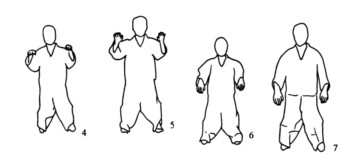
ZUO PENG - Left Ward Off
To move into this posture your waist turns to the right and your weight shifts on to the right leg. This begins the practice of shifting the weight on to one leg, "screwing" it into the ground, and in the process storing up the tai chi spring power of the legs and then releasing it into the next move. This is what Cheng Man Ching referred to as "swing and movement", whereby potential energy stored up from one movement is converted into kinetic energy producing the next movement. As in all the movements of the form the hands follow the turning of the waist.
As you move into the Left Ward-Off, the form teaches you to use the angles your body is creating. So, although the general "feel" of the movements is rounded, you are always seeking the straight line in the curve. In practical terms this can be seen in the transformations that occur as you move into left peng.
First the weight is on the right leg and the waist is turned to the right. Then the left leg steps out straight with the left hand following it forward. Next the waist is turned, bringing with it the back foot, pivoting on the heel, and turning the left hand so that the left forearm ends up facing front. So it is that within this one apparently simple movement occur a number of changes from curved to straight and back again. The whole movement is accomplished, however, with the bulk of the work being done by the legs and the waist. This feeling should be reproduced throughout your tai chi practice, so that the legs provide a platform for the free-moving, relaxed upper body. Bearing all this in mind you are now ready to perform ZUO PENG.
Having completed CHI SHI, shift your weight to the left leg, taking care that your hips remain on the same level. Then turn your waist to the right, allowing your right foot to pivot around on the heel through ninety degrees. At the same time your left hand moves around, following the waist at waist height, palm up, while the right arm raises up to chest height, palm down. Thus the two hands are placed as if holding a football in to the body. Take care that you keep the arms away from the body by making a space under both armpits. Now shift your weight to the right foot.
The left leg which remains firmly on the floor will now start to feel strained so allow the heel to raise and the knee to sink. Next you step out with the left leg directly to its front. You must make sure that you have stepped out far enough so that you will be able to form a front stance when the move is completed. About one and a half shoulder-widths is enough. As you step, the heel is put down first. Then shift your weight to the left leg, at the same time allowing the left hand and arm to rise up while the right arm drops at your side. The left arm moves up and out, with the palm facing in at about chest-height and the forearm about a shoulder width away from your chest. As in all the tai chi movements the elbows hang down.

